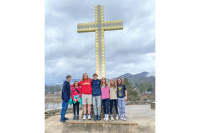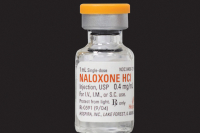Manana is a shocking, dark and fantastic read
 I have been waiting for this book for a long time. Back in 1978, I read Falling Angel, which was that rare thing, a dark blend of noir/thriller and the occult. I read it several times, and it seemed to get better each time. It was made into a pretty decent film, “Angel Heat,” which had two of my favorite actors, Mickey Rourke and Lisa Bonet.
I have been waiting for this book for a long time. Back in 1978, I read Falling Angel, which was that rare thing, a dark blend of noir/thriller and the occult. I read it several times, and it seemed to get better each time. It was made into a pretty decent film, “Angel Heat,” which had two of my favorite actors, Mickey Rourke and Lisa Bonet.
Hjortsberg’s novel ended up on my shelf for “the best novels I have ever read,” and left me wondering if the author could ever create another work like that. The answer is ... “Maybe.” I had to think about Mañana for a while, but perhaps he has done it again. I am still thinking about it.
Mañana takes place in Mexico during the mid-60s, a place that, thanks to movies like “A Touch of Evil” and a dozen Ray Bradbury short stories, I have come to associate with the grotesque and sinister. The narrator is an expatriate hippie named Todd who spends much of his time smoking pot and driving his battered Volkswagen (which he calls “Bitter Lemon”) through a landscape that alternates between desolate farmland and tourist-infested villages filled with gaudy signs (Corona, Pacifica, Coca-Cola), pastel slums and huge memorials to Mexico’s bloody past.
The Bitter Lemon is stocked with iced beer (Pacifica) and R. Crumb comics (Zap). What had begun as “another day in Xanadu” has turned into a terror-ridden journey through a death-haunted land. For most of this novel, Todd is searching for his wife, Linda, who may be dead, kidnapped or merely absconded with some of Todd’s unsavory friends like Shank or Doc or Nick. Todd is just coming down from his first experience with heroin and can’t remember exactly what went down at that last party.
Todd suspects the worst because when he wakes up, he is in bed with a dead prostitute named Frankie. Somebody has cut her throat with Todd’s favorite knife, a razor-sharp Randall. Could it have been Todd? Why have his newly made friends abandoned him? He and Linda are New York natives who had been on a drug-fueled trip through Guadalajara when they befriended Shank (an addict and murderer); Doc (obese, pompous and having an irritating habit of quoting the poet Kahlil Gibran); Nick (an addict who always dressed in black), and three thieves who obviously know their way around Mexico’s underworld. They had robbed a New York jewelry store which specialized in expensive watches and had stolen a red Pontiac Firebird which they had driven straight to Guadalajara. They intended to contact a dealer in stolen goods, but it seems that they also had long-range plans for another heist — a million dollar drug operation on a strawberry farm outside Guadalajara.
Todd and Linda joined the drug-fueled party and followed a kind of movable feast of acid, food and sex which makes its way from sleazy hotels to bullfights, bizarre wrestling matches and cockfights. Ah, but something is wrong and events are spinning out of control. Todd becomes apprehensive about his wife’s growing fascination with expensive watches, drugs and violence, and by the time he wakes in a blood-soaked bed with a dead prostitute, his bacchanalian holiday has turned into a nightmare.
Related Items
Todd soon discovers that Linda has withdrawn all the money in their bank account. Did she do it willingly or was she forced to? Strapped for cash, Todd is reduced to peddling pot to tourists and “spring break” college students (he has an impressive stock concealed in the Bitter Lemon). Living out of the battered VW, he quickly finds himself in trouble with knife-wielding juvenile drug dealers and night-roaming bandits. In the meantime, he continues to search through Guadalajara’s back streets and tourist traps for his wife. Is it possible that Linda willingly abandoned him for the company of the three thieves or is she dead, murdered? At night, his dreams are filled with his memory of Frankie, the dead prostitute. Did he kill her?
William Hjortsberg has a marvelous gift for creating a dark and sinister backdrop for his tales. At times, Mañana pulses like an opium dream with a pastiche of disquieting imagery. It is Easter in Mexico and the streets are filled with religious images. Todd finds himself swept up in passion plays in which a bloody Christ struggles with a giant cross; “Day of the Dead” celebrants lurch through the streets, laughing and singing and obscene Punch and Judy shows provide a counterpoint a short distance away. Due to a solar eclipse, the moon acquires a bloody hue which adds to Todd’s distress and sleeplessness. At one point, Todd tracks one of the thieves into a popular tourist attraction that is an underground “city of mummies” where thousands of skeletons have become macabre exhibits.
Is this emphasis on the shocking and bizarre a bit excessive? Oh yes, but Hjortsberg does not relent and Mañana maintains a kind of “Grand Guignol” charm right to the bloody end. Why? Well, frankly, in addition to writing a hell of a novel, I think Mañana is a kind of tribute to a half-dozen writers that Hjortsberg admires.
For example, there is a lot of Jim Thompson here. For anyone who has read Thompson’s The Getaway (or has seen the film version) and The Killer Inside Me, the similarity to Mañana is obvious. Thompson frequently uses a doomed narrator (and yes, Todd is doomed) who is fated to find out that “things are not what they seem.” There are also scenes that owe their origin (or perhaps I should say “their inspiration” to Jack Kerouac who made his own surreal sojourns into Mexico. Hjortsberg makes several references to the Orson Welles film, “Touch of Evil” (Nick, one of the thieves, wears a T-shirt inscribed with the film’s title) and then, there is Cormac McCarthy, who is the master of “noir” in modern literature. In fact, Mañana depicts the same dark vision of the human heart that is found in much of McCarthy’s work.
My favorite scene in Mañana (other than the Jim Thompson ending which I must confess, I didn’t see coming) is a quirky little scene in which Todd dines in an upscale restaurant and develops a taste for the bowls of “appetizers” that are served with his meal, toasted pumpkin seeds and “gusanos.” After consuming several bowls, much to the amusement of the waiter, Todd finally asks, “What are gusanos?”
The waiter smiles and says, “Gusanos are fried maggots, sir. They are considered a delicacy in Mexico.”
This could have happened to Jack Kerouac. In fact, I think it did. South of the Border, according to Jim Thompson, “nothing is what it may seem.”
Mañana by William Hjortsberg. Open Road, 2015. 228 pages.









